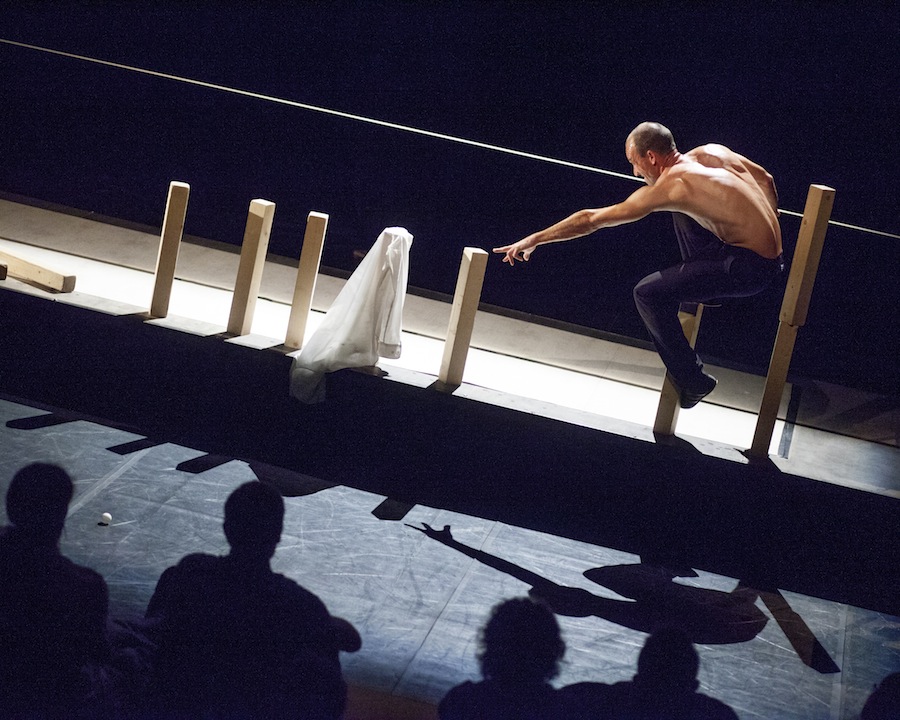Southbank Centre, London International Mime Festival; 11th January 2015
*Originally published in Exeunt

Circus exists at the point of balance where one object ends and another, human object, begins. Lonely Circus, a French company founded 15 years ago by wire walker Sébastien le Guen, have produced in FALL/FELL/FALLEN a show that keeps these points fluid and shifting. Most prominently is the essential interplay of Le Guen’s physical acts with the electronic composition of onstage partner Jérôme Hoffmann, each influencing and informing the other in what the pair have termed ‘electro-circus’ – ‘exploring the sound of circus and creating music to be seen as well as heard.’
A raised stage upon a stage is raised again with a bank of desks squared to form a ‘band stage’ of technical apparatus. Thin metal rods stand vertical upon a workbench, while a drummer’s stool glints beneath; a balled-up sheet of foil fills the wastepaper bin, and an electric guitar lies horizontally across a tabletop. At the other side of the stage, a speaker bowl of white ping pong balls rests in front of neatly stacked blocks of wood, waiting as if in readiness for a well-organised game of giant jenga.
The theatre’s mobile phone announcement leaves a low reverberating bass note that persists until Hoffmann enters, wiping his feet with a pronounced squeak at the threshold of his band stage territory. His sandy coloured shirt matches the wooden blocks opposite and, when Le Guen appears from that direction, we see his dark suit complimenting Hoffmann’s computer screens and sound desk equipment. There is a lot of yin and yang at play here, from the intense concentration and the wry humour, down to the luxurious mad-scientist mop of Hoffman’s hair contrasting Le Guen’s bald pate.

The purpose built stage that allows for the later tightrope (tape) rig is also fully fitted with microphones and speakers. The functional sounds created from the actions of Le Guen become integrated within Hoffmann’s live looping composition, and the vibrations sent out from Hoffmann’s sound station affect the precariously balanced objects in Le Guen’s realm. This is somatic DJing.
Le Guen himself is a ferry between our world and the one he shares with Hoffman (who is always focussed within the bounds of the stage). The noises that permeate the air are a consistent bridge that links us all. There is humour in the jam, and a frisson of uncertainty sprung from the inexact nature of balance.
During the post-show talk, a member of the audience asked, ‘Is it really dangerous, or does it just seem dangerous?’ I found this an interesting response because, while watching the show, I had written that, although the build in sounds would suggest a build in tension, I don’t feel tense because there doesn’t seem to be anything serious at stake. The show will be fine regardless of what happens, every element incorporated through the framework of two-way communication and improvisational space. I don’t sense danger until the final moments of the show, when a heavy wooden plank spins from a central point, threatening to impact Le Guen’s bare flesh as he manoeuvres around it. The question is a reminder that we all have different thresholds of danger.
Le Guen’s reply is that, for him, the danger is in the ego, and the stakes are in the personal challenges of his technique. He has a particular interest in creating a feeling of danger without it actually being present. He is dismissive about the physical risk: ‘I could break a leg, but…’, with a wave of his hand.

Hoffmann explains that the section of the show that has proved most dangerous so far is a sequence of slips, slides and dives across a wet stage after Le Guen has covered himself in water. In the early days, he would overshoot the stage, or collide with onstage objects, ‘Blood and water… that was a special show’, remarks Hoffmann. He also acknowledges, however, that the act of balancing on wooden posts that’s so simple for Le Guen can be dangerous for someone who is not a trained equilibrist.
In today’s show, the twisted tower built to support the horizontal plank before its spin collapses earlier than planned. For the performers though, this moment is still juste, true to the show, right in its integration with sound and light despite its surprise incidence.
I have asked about the balance between plan and jam within the performance, impossible for me to discern as a first time viewer. Hoffman clarifies:
‘The places to jam are planned, they are in the nature of circus. I don’t know what’s going to happen two seconds later – the jam is there in the possibility of the accident. It’s another pleasure for us, onstage, not knowing what’s going to happen. We like the idea to play with this border, to see how far it will go.’
In the precision of touch needed to interact with his wooden objects, Le Guen appears at times more of a juggler than an equilibrist, and another bridge is provided, this time between the two disciplines. The evolving soundtrack teeters impenetrably in a further balance between samples and live sounds.
FALL/FELL/FALLEN, like the transitioning verb of it’s title, refuses to stay in one place long enough to be pinned down, continually deifying conventional categorisations and opening up refreshing perspectives in a highly skilled hour-long balancing act.
.
.




